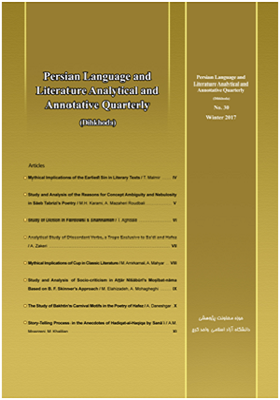Study and Analysis of the Reasons for Concept Ambiguity and Nebulosity in Sāeb Tabrizi’s Poetry
Subject Areas : Persian language and literature textsDr. Mohammad Hossein Karami 1 , Ali Mazaheri Roudbali 2
1 - استاد زبان و ادبیات فارسی.دانشگاه شیراز.شیراز.ایران
2 - دانشجوی دکتری زبان و ادبیات فارسی.دانشگاه شیراز.شیراز.ایران
Keywords: innovation, سبک هندی, صائب تبریزی, Indian style, ambiguity, ابهام شعری, تازه گویی, دیریابی, طرز نو, معنی بیگانه, nebulosity, Sāeb Tabrizi, unfamiliar meaning,
Abstract :
Sāeb Tabrizi, as a representative of a poetic style known as innovative, fresh and contriving, is one of the most prominent gazal composers in Iran, and his poetry is believed to fall in the midst of the two main streams of Indian style: the plainly unadorned style (employed by the relatively analphabetic and common poets of the genre) and the quaintly sophisticated one. Late in sixteenth century the Persian versification took a route to an enigmatic intricacy which resulted in ambiguities brought about by language manipulation and semantic deviation. It was an attempt to discover new relations and to create paradoxical images. The typical features that make together his verse ambiguous are different from those belonging to Hafez and Rumi’s versification. Ambiguity in the poems of these two is because of the span of meaning. Moreover, ambiguity in Sāeb’s verse is different from the ambiguity existing in the poems of Anwari and Ḵhāqāni who let in their verses scientific, philosophical, historical and religious comprehension. This article studies those elements – mostly aesthetic ones – which make Sāeb’s verses ambiguous. Sāeb’s intention to invoke certain ambiguity in his poems and his mastery of aesthetic applying of it are among the findings of this article
_||_

